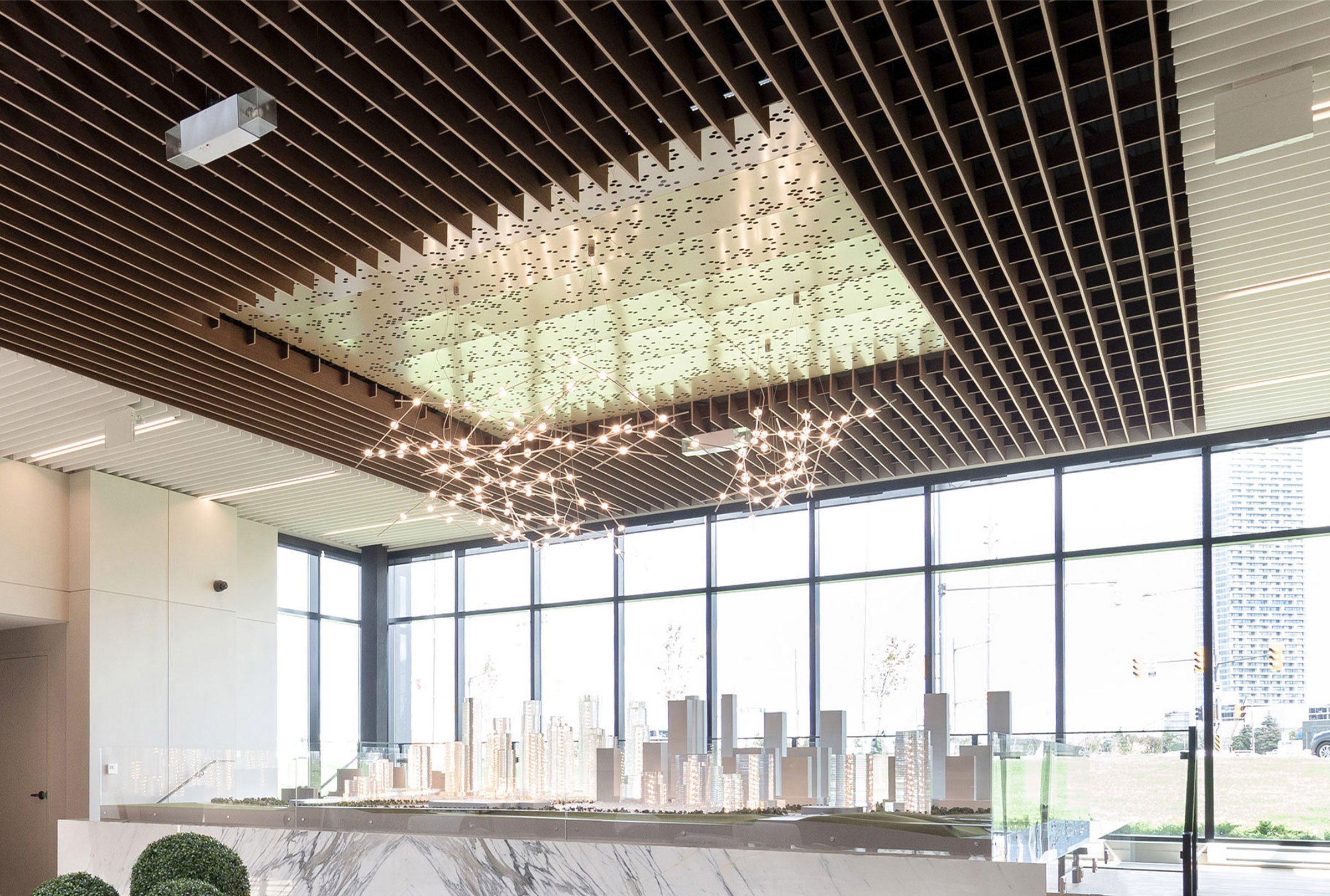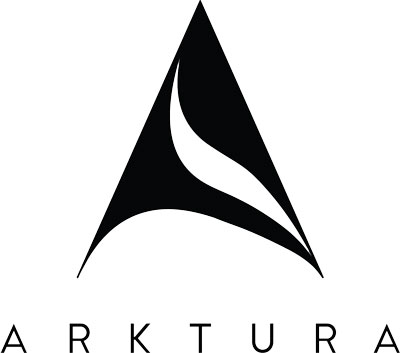In a world of absolutes, of this or that, black or white, modern-industrial or ’70s bohemian chic, the best answer often lies in a middle ground—nestled between the two extremes. This same approach also applies to our built environment. In the beginning stages of a project, the question will naturally arise: Will this be a preconfigured, out-of-the-box system or a custom solution? Each approach has its advantages and drawbacks to consider, depending on the scale and design intent.
Which system is right for you will require some additional thought. A preconfigured, kit-of-parts system is needed based on time and budget constraints. But will the simple kit system provide the best performance, intent, and quality? Arktura has innovated a way to strike a balance between knowing the best project specs to dial in through early coordination, specifying the simple kit-of-parts system, or a more complex and dynamic custom solution.
The Benefits of Preconfigured Architectural Systems
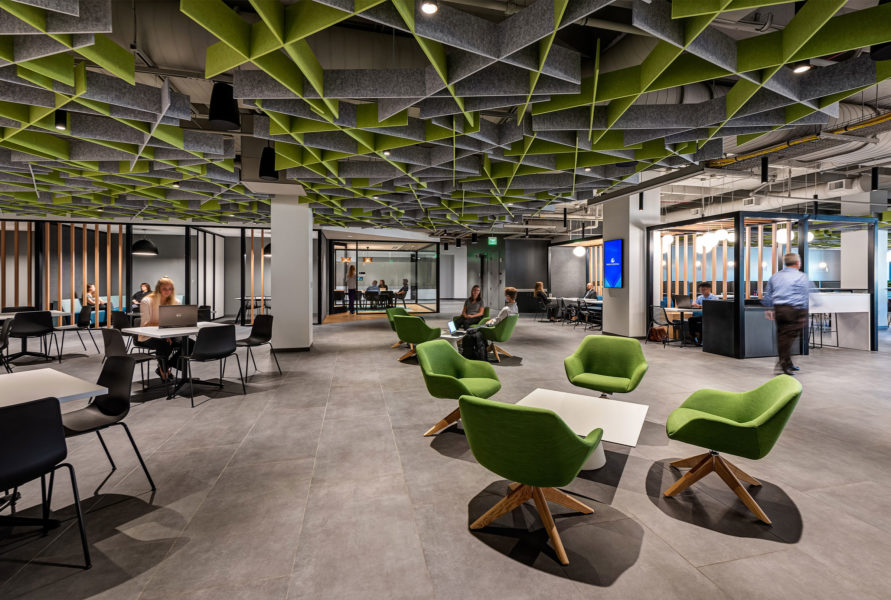
The dual tones of SoftGrid Switch make these baffles stand out while being subtle enough to blend into the room’s decor at Medical Mutual of Ohio, designed by Bialosky Partners in Cleveland. Photo by Christian Phillips Photography
A “one size fits all” approach to architectural systems is a bit of a myth. While preconfigured architectural systems may ensure efficiency, they might not resonate with every client. By contrast, a custom project may help maximize intent and enhance the overall experience, but it may present budget or scheduling obstacles, and as a result, become challenging to scale or systematize for ease of installation and reaching intent.
Defining these terms in this industry-specific example is essential before getting into standard versus custom specifics. For architectural and acoustic systems, like the ones provided by Arktura, standard products refer to ready-made to order, preconfigured systems. “Launching standards some seven or eight years ago was the coup de grace for Arktura’s portfolio offering. The thoughtful designs incorporating aesthetics, accessibility, and both ease and flexibility (trimming in the field) of installation rounded out and completed our portfolio,” says Rich Gesteland, senior sales director at Arktura.
These are featured products in our catalog and website where customers can view a product, see images in real-life typical or non-typical specs from a previous project, then contact a rep to specify that system for their project. This process is akin to finding a product you love on Amazon—it arrives just as it was described in the online listing. In our case, the systems arrived at the job site just as they appeared on our site and images, per the submittal approval process.
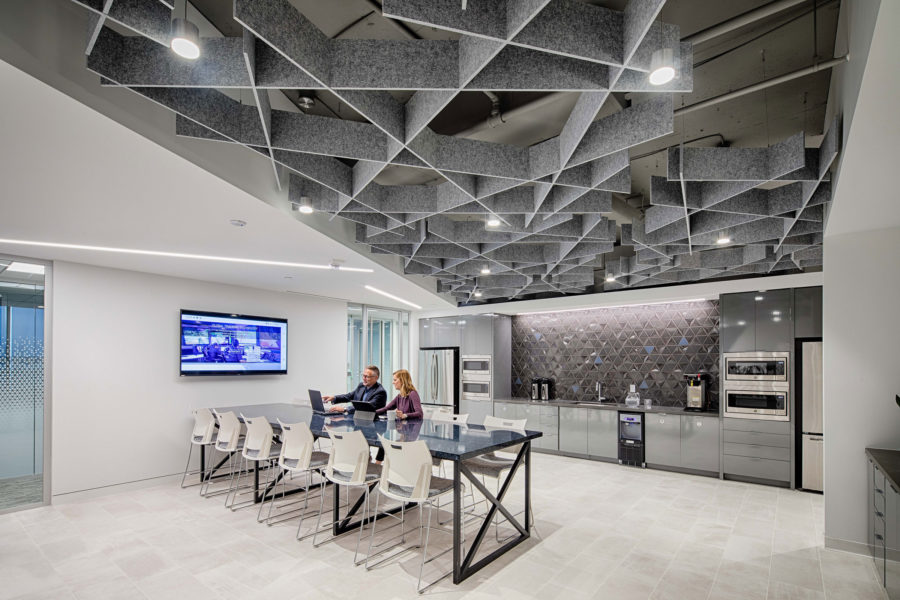
The zig-zag patterns of the SoftGrid Switch create a sense of motion, perfect for gathering spaces at Constellis, designed by DBI Architects in Lorton, VA. Photo by Matthew Borkoski Photography
Establishing a measurable level of quality and control helps a brand grow and boosts consumer confidence. This process has many advantages to both the manufacturer as well as the architect, installer, and end client.
Gathering spaces at Constellis in Virginia are a great example of how the products you ordered will appear as intended and will have undergone a quality control phase in production. This consistency is beneficial for projects both large and small where the quantity and configuration of a specific system and specified accessories make quality and precision crucial.
“Another advantage is the testing that our preconfigured systems have been through. These systems have been thought out and rigorously tested. When you use those systems, it is also easy to order replacement parts or hardware,” says Eric Lopez, systems development coordinator at Arktura. This consistency is what customers value, as it creates brand unity and leads to return purchases driven by ease of budget, installation, schedule, performance requirements of the system, and project completion.
There are also advantages for manufacturers to produce uniform products consistently. Offering uniform products allows for a range of innovations from revisions and improvements to installation manuals, layout drawings, key plans, and brochures based on feedback from the field. Using uniform products saves time on planning, and most importantly can improve a project’s success. Specifying standardized products can also lead to more development, resources, and testing going into the overall project, versus more of a complex system.
Modifying Standard Solutions
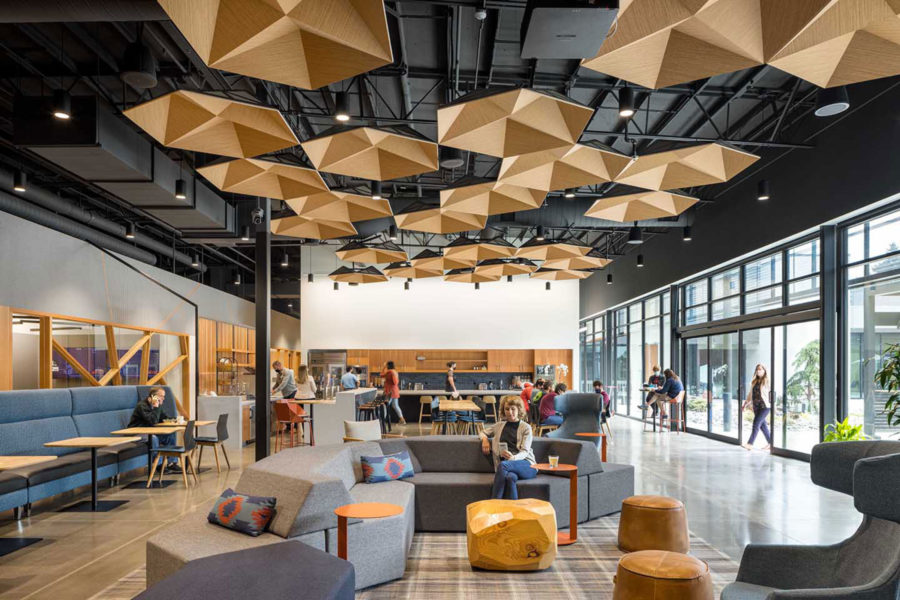
SoundStar systems available in natural wood textures create a focal point that does anything but blend in at Absci, designed by Bora Architects in Portland, OR. Photo by Josh Partee
Developing a standardized product does not mean that it is the end-of-life cycle for that product. With slight upgrades, revisions, and improvements over the years, a standard product can have a renewed sense of life and efficiency. Offering a standard product is beneficial to all, as these products can keep a manufacturer’s brand name relevant, allow installers to be familiar with the schematics of the products they are handling, and give consumers the latest and greatest from your company.
“Kit-of-parts is a defining element of most of our adaptive offerings. Using our parametric design software, we can create an almost infinite variety of designs with a surprisingly small number of design elements. This helps us hit that sweet spot in architectural design between budget and unbridled intent,” says Gesteland. This was the case with Arktura’s own Vapor® panels. Over the years these versatile wall and ceiling systems have been one of our top selling lines. Constant upgrades, new designs, features, and patterns keep this collection at the forefront of architectural design.
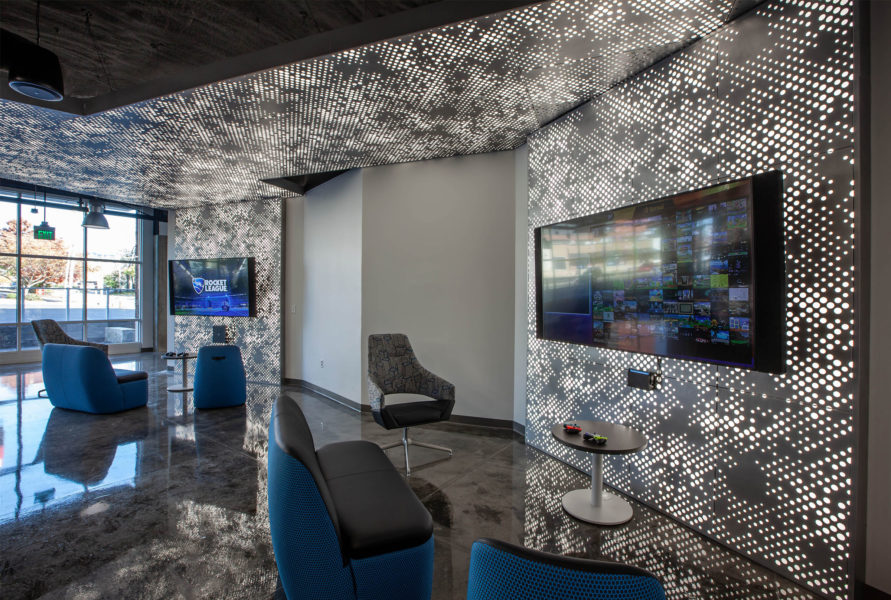
Vapor Cumula panels with optional backlighting transition seamlessly from wall to ceiling for a creative and curated design at The Cornerstone, designed by Sherman Carter Barnhart Architects in Lexington, KY. Photo by Chris Phebus Photography
But what if this standard, out-of-the-box system isn’t suitable for your next project? What if you had a different vision than what is available in the photos of our catalog or the specs of our systems and accessories?
Before going over to the opposite end of the pendulum and creating a fully customized spec project, it is worth looking at what options you have within the confines of standard. This could relate to finishing, size, and optional accessories to bring a more individualized touch to preconfigured products.
“Our early standards were born of popular Solutions Studio (fully custom) projects and products. They brought Arktura to the rest of our markets, the middle of America, and the budget-sensitive projects. Standards is the balance we struck,” says Gesteland. These tailored preconfigured systems may sound like a misnomer, but thanks to assorted options such as material, finish options, and layout/configurations, it is simple to get a more curated look from our standard designs.
Working to Fit a Client’s Vision
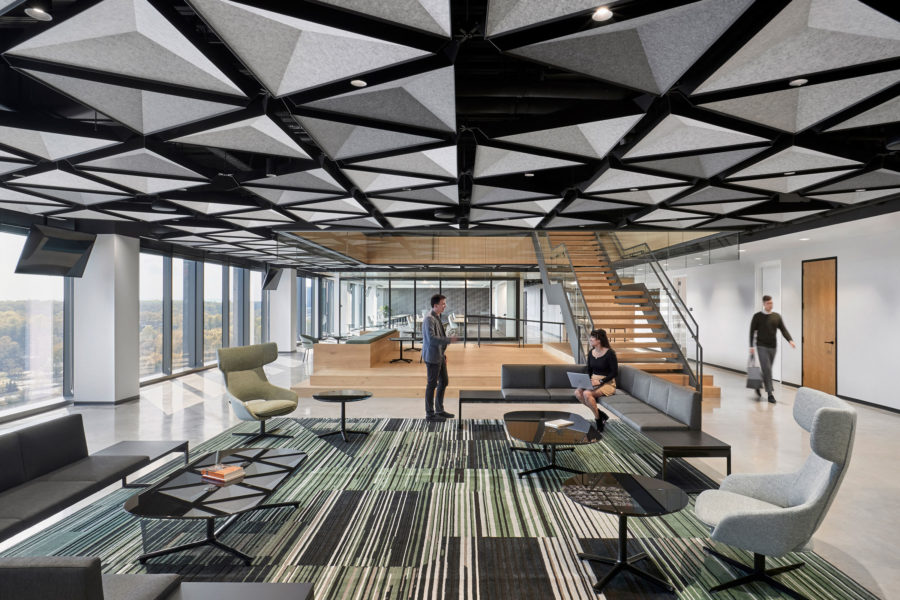
Incorporating brand colors like in the ceiling clouds above at Neustar—designed by HKS Architects in Reston, VA—is an easy way to get a customized look from standard systems. Photo by Garrett Rowland Photography
Arktura offers a wide variety of custom options to create a more personalized finish to our existing preconfigured architectural systems. For example, our standard Vapor metal wall and ceiling panels come in traditional powder coat finishes, as well as a colorful array of premium finishes and customized color matching options. This custom color matching is ideal for a client’s brand colors to be on full display, giving the look of a fully customized project. Adding optional backers can also introduce a series of Soft Sound PET (polyethylene terephthalate) acoustic color options. A premium wood texture finish is available for a more modern look. Supplementing the final project with client logos can put a bow on a modified, but preconfigured project.
More curated and custom projects come with advantages over simple standard products, like fully executing a client’s vision. Putting more design control in the hands of the client allows a more individualized touch on the final project. Since practices, usage, and communities vary, localizing a product with more custom options and accessories may be more beneficial.
If a potential client is looking for a fully custom, made-to-order system outside of our traditional preconfigured products, Arktura’s Solutions Studio can bring that vision to life. Through a collaborative process between a client, our project managers, and more from our team, Arktura’s Solutions Studio can fully realize design intent and execute the unique demands of any project. This process results in truly breathtaking projects that would normally not be possible with a standard, kit-of-parts approach.
Using Design Intent to Create a Custom Look

These mechanical facades were custom-made for Brick and Machine in Culver City to exemplify this Abramson Architects project’s name and theme. Photo by Sean Costello Photography
Another beneficial way to nail the look of a custom project without burning through a budget is through proper design intent. A client can utilize multiple standard products that follow a similar or congruent design language to create a fully realized space that looks and feels made to order.
“Having an architect or designer layout the preconfigured architectural systems from Arktura when using multiple systems helps achieve a more customized look. Some of our ceilings integrate well with one another, such as SoundStar and the SoftGrid Hex,” says Lopez.
Keeping a harmonious design throughout can significantly impact the finished environment. For example, Signature FS’s new FBO terminal at Nashville International Airport captured this perfectly. Utilizing Graphic Perf® Custom Photoreal Exterior treatments allows the client’s branding to come through from the moment you lay eyes on these panels to reflect on Nashville’s musical legacy. Inside the terminal, you will find Atmosphera Linea and SoftGrid Wave acoustic ceiling baffles that are designed in a similar finish to bring a cohesive design intent to the terminal’s interior.
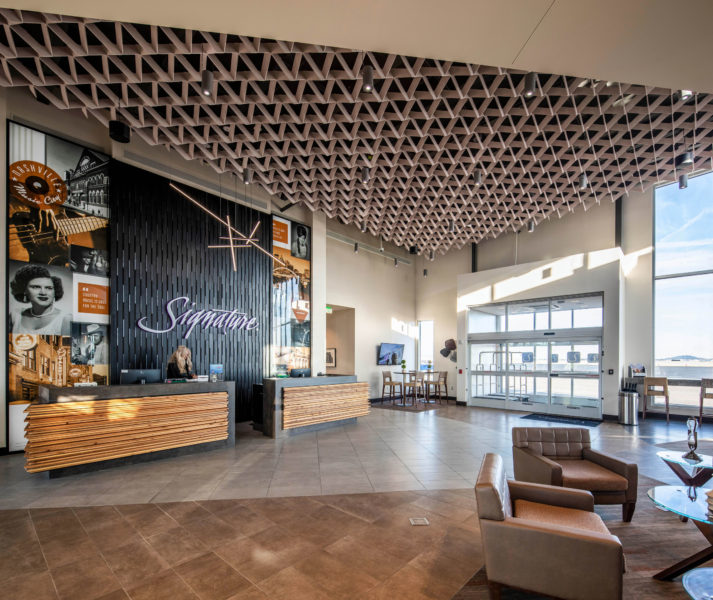
Nashville’s “Music City” moniker comes to life in these expansive acoustic ceiling baffles at NA Nashville Terminal, designed by Corgan in Nashville. Photo by Chad Baumer Photography
With Arktura products, your next architectural solutions project can meet your design intention whether it is standard, preconfigured, kit-of-parts, or fully customized through Arktura’s Solutions Studio, or somewhere in between. Thanks to our extensive library of finishes, materials, and additional accessories it is simple to add a touch of light customization to a preconfigured system allowing your design and vision to shine through or even enhance a space with a client’s specific branding. There is no one process to rule them all, but each of Arktura’s dedicated teams are ready to assist and see your dream project come to life.

